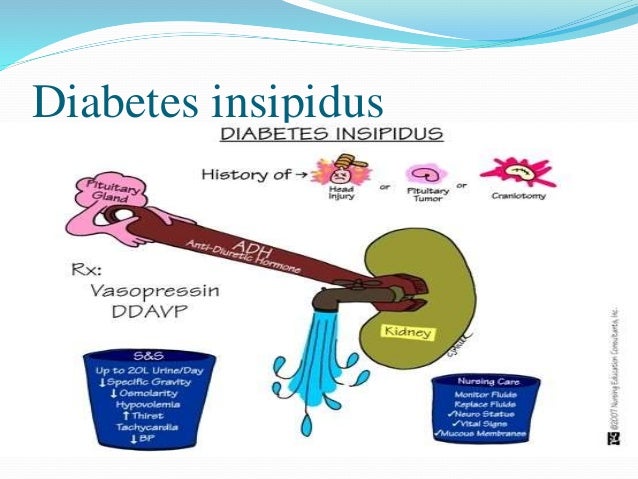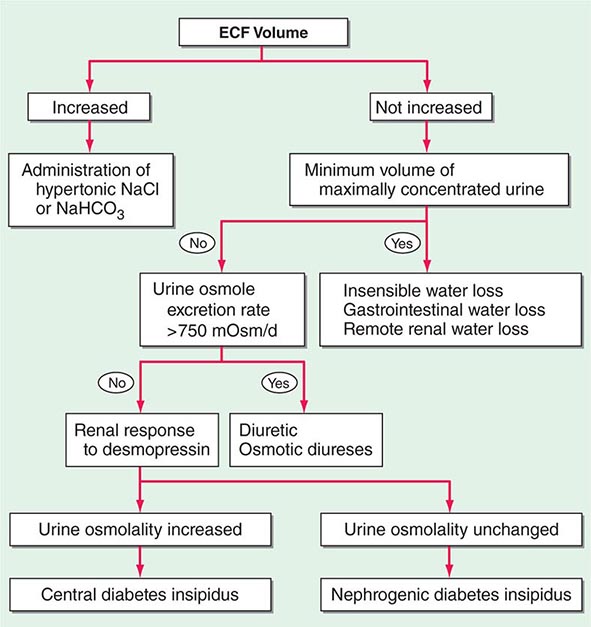Diabetes Insipidus Electrolytes
Clinical trials. explore mayo clinic studies testing new treatments, interventions and tests as a means to prevent, detect, treat or manage this disease.. lifestyle and home remedies. if you have diabetes insipidus: prevent dehydration. as long as you take your medication and have access to water when the medication's effects wear off, you'll prevent serious problems. Diabetes insipidus (di) is a condition characterized by large amounts of dilute urine and increased thirst. the amount of urine produced can be nearly 20 liters per day. reduction of fluid has little effect on the concentration of the urine. complications may include dehydration or seizures.. there are four types of di, each with a different set of causes. Diabetes insipidus is a rare disorder that occurs when a person's kidneys pass an abnormally large volume of urine that is insipid—dilute and odorless. in most people, the kidneys pass about 1 to 2 quarts of urine a day. in people with diabetes insipidus, the kidneys can pass 3 to 20 quarts of. Diabetes insipidus can be caused by two flaws in this process: the hypothalamus isn't making enough vasopressin or the kidneys aren't responding to the hormone. either way, the result is the loss of too much water in the urine, leading to the characteristic symptom of excessive thirst.
More diabetes insipidus electrolytes images. Two major complications of diabetes insipidus are dehydration and an diabetes insipidus electrolytes electrolyte imbalance. desmopressin is a synthetic form of vasopressin used to treat diabetes insipidus. to treat this condition naturally, you must be sure to drink enough water to stay hydrated, watch your medications (some may be altering fluid balance), and change your diet. Uptodate, electronic clinical resource tool for physicians and patients that provides information on adult primary care and internal medicine, allergy and immunology, cardiovascular medicine, emergency medicine, endocrinology and diabetes, family medicine, gastroenterology and hepatology, hematology, infectious diseases, nephrology and hypertension, neurology, obstetrics, gynecology, and women. Diabetes insipidus can also cause an electrolyte imbalance. electrolytes are minerals in your blood that have a tiny electric charge, such as sodium, calcium, potassium, chlorine, magnesium and bicarbonate.

In nephrogenic diabetes insipidus, the goal is to prevent dehydration by increasing water intake while reducing salt and protein in the diet. some patients may be encouraged to take nsaids or thiazide diuretic to decrease the amount of urine that is excreted from the body. Diabetes insipidus (di) is defined as the passage of large volumes (>3 l/24 hr) of dilute urine (< 300 mosm/kg). it has the following 2 major forms: central (neurogenic, pituitary, or neurohypophyseal) di, characterized by decreased secretion of antidiuretic hormone (adh; also referred to as arginine vasopressin [avp]) nephrogenic di, charac. Diabetes insipidus is a rare disorder that occurs when a person's kidneys pass an abnormally large volume of urine that is insipid—dilute and odorless. in most people, the kidneys pass about 1 to 2 quarts of urine a day. in people with diabetes insipidus, the kidneys can pass 3 to 20 quarts of urine a day.
Diabetes Insipidus Symptoms Causes Treatment Nursing
Diabetes insipidus wikipedia.
Diabetes insipidus (water diabetes) is a rare condition caused by a reduction in, or failure to respond to, anti-diuretic hormone. this results in passing large amounts of dilute diabetes insipidus electrolytes urine and increased thirst. this can result in an imbalance of electrolytes in the blood, possibly causing symptoms such as headache, fatigue or muscle pain. Diabetes insipidus is a condition characterized by large amounts of dilute urine and increased thirst. the amount of urine produced can be nearly 20 liters per day. reduction of fluid has little effect on the concentration of the urine. complications may include dehydration or seizures. there are four types of di, each with a different set of causes. central di is due to a lack of the hormone vasopressin. this can be due to injury to the hypothalamus or pituitary gland or genetics. nephrogenic d. Diabetes insipidus (di) is an uncommon condition with either relative or absolute lack of anti-diuretic hormone (adh) leading to inability to concentrate the urine and subsequent polyuria/polydypsia and potentially fluid and electrolyte imbalance. this can be seen in a variety of conditions in the paediatric population, most commonly in.
Diabetes Insipidus Wikipedia

Only a laboratory testing is able to confirm the presence of diabetes insipidus. these tests in some form have been available in the united states since the 1930s. if the clinical presentation of this condition is suggested by the signs and symptoms diabetes insipidus electrolytes being suffered, then a medical provider will order a 24 hour urine collection Nephrogenic diabetes insipidus usually affects males, though women can pass the gene on to their children. complications dehydration. diabetes insipidus may lead to dehydration. dehydration can cause: dry mouth; changes in skin elasticity; thirst; fatigue; electrolyte imbalance. diabetes insipidus can cause an imbalance in electrolytes — minerals in your blood, such as sodium and potassium, that maintain the fluid balance in your body. symptoms of an electrolyte imbalance may include. Diabetes insipidus is a rare condition where the body cannot retain enough water. it occurs in approximately 1 in 25,000 people, and can affect anyone of any age, although it is more common in adults.

In central diabetes insipidus, the history of polyuria and polydipsia is usually abrupt, presenting within weeks or months of onset. 3 in nephrogenic diabetes insipidus, the onset is more insidious and patients have often had symptoms for months or years before the diagnosis is made. 2 symptoms suggestive of pituitary disease may include fatigue, dizziness, irregular periods, and galactorrhoea. Nephrogenic diabetes insipidus is a long name for an uncommon condition. diabetes insipidus electrolytes nephrogenic diabetes insipidus is not the same as diabetes mellitus. diabetes mellitus causes elevated blood sugar levels. In complete central diabetes insipidus, testing reveals minimal adh levels and activity, with failure of the urine to be concentrated despite excessively concentrated serum. in response to exogenous vasopressin, urine osmolality increases by more than 50%. If left untreated, complications of diabetes insipidus include dehydration or an imbalance of sodium, potassium, or other electrolytes in the body. condition is not related to diabetes mellitus. diabetes insipidus is a relatively rare condition. it is not related to diabetes mellitus, although they share the symptoms of excess thirst and urination.
Electrolyte imbalance in diabetes is primarily a result of elevated blood glucose. with hyperglycemia, the body tries to rid itself of the excess blood glucose by increasing urinary output. increased urination produces water and electrolyte loss, which then upsets the body’s balance of electrolytes. Diabetes insipidus (di) is defined as the passage of large volumes (>3 l/24 hr) of dilute urine (< 300 mosm/kg). it has the following 2 major forms: central (neurogenic, pituitary, or.
Diabetes insipidus is a different disease from diabetes mellitus. their names are similar, but the only things they have in common is that they make you thirsty and make you pee diabetes insipidus electrolytes a lot. Baseline investigations should include urea and electrolytes, full ward test of urine and paired serum and urine osmolality. diabetes insipidus is present when the serum osmolality is raised (>295milliosmol/kg) with inappropriately dilute urine (urine osmolality < 700milliosmol/kg). the serum sodium is often elevated due to excess free water losses.
Diabetes insipidus can cause an imbalance in electrolytes — minerals in your blood, such as sodium and potassium, that maintain the fluid balance in your body. symptoms of an electrolyte imbalance may include:. The 2 main complications of diabetes insipidus are dehydration and an electrolyte imbalance. complications are more likely if the condition goes undiagnosed or is poorly controlled. dehydration. if you have diabetes insipidus, your body will find it difficult to retain enough water, even if you drink fluid constantly. Diabetes insipidus is rare, with a prevalence of 1 in 25 000. 2 central diabetes insipidus usually results from pituitary pathology,3 either as a result of infiltrative or inflammatory pathology, or following surgery for a pituitary tumour, but may also be due to a congenital defect in the production of arginine vasopressin. 3 nephrogenic diabetes insipidus is usually caused by electrolyte disturbance, renal disease, or drug toxicity (commonly lithium2).

Comments
Post a Comment